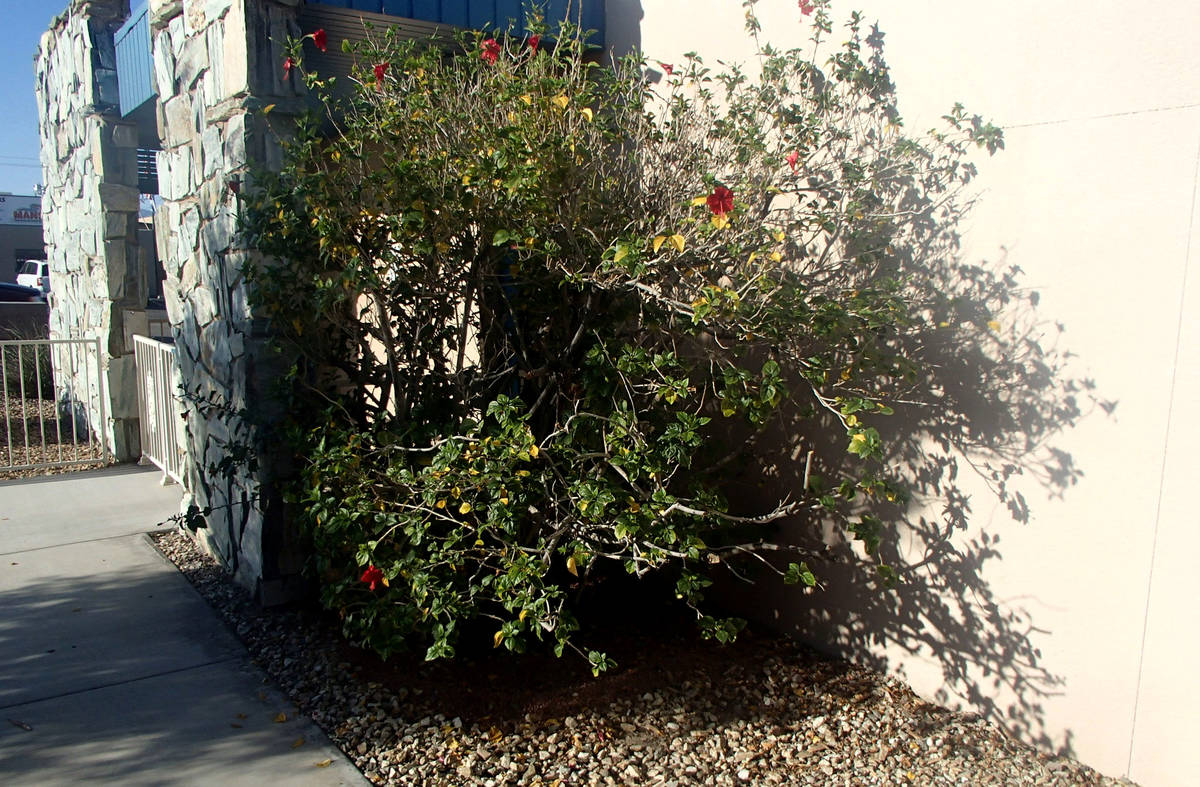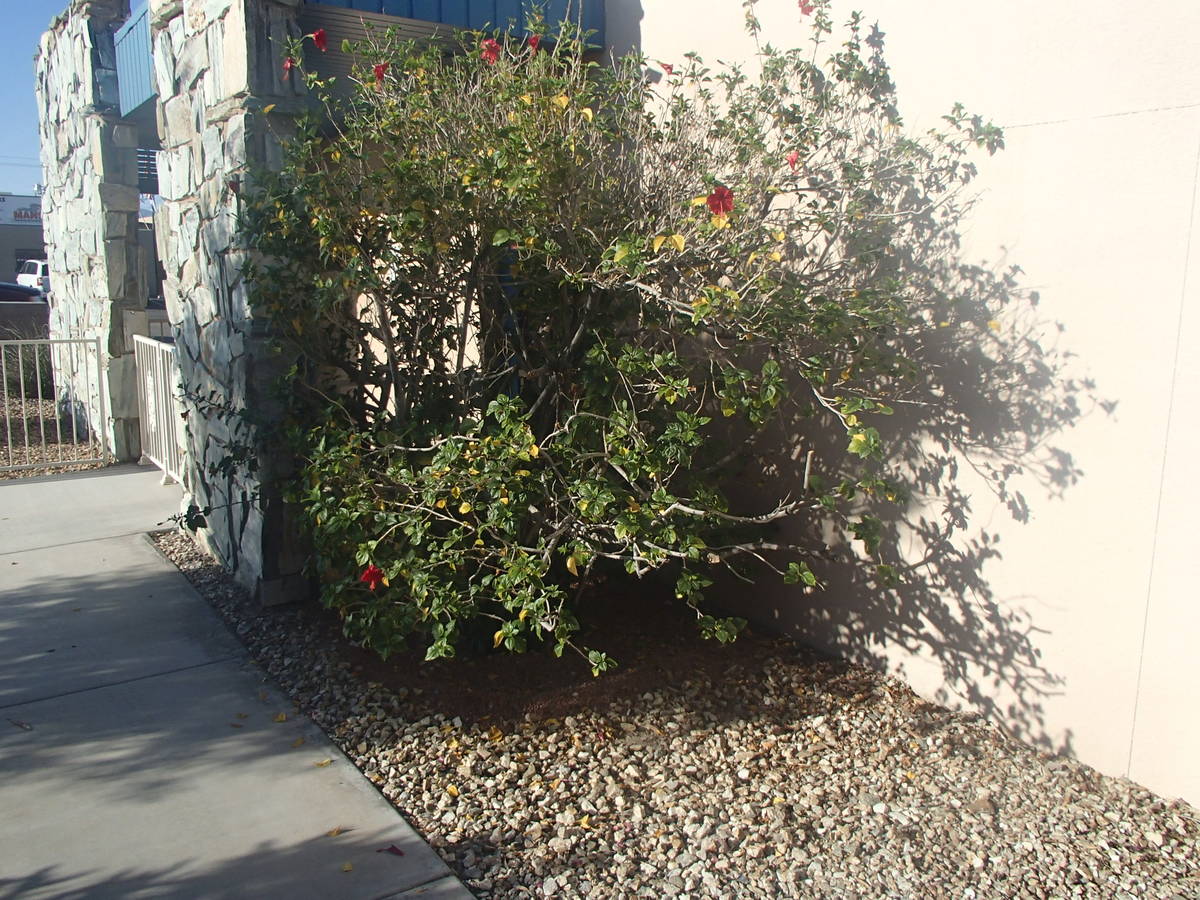Though hard to find, Rose of Sharon grows well in our climate
Q: I just saw Rose of Sharon (Hibiscus syriacus) for sale at a local nursery. It reminded me of a yard I saw over 40 years ago in the Huntridge area that had a row of these plants which were spectacular. I was wondering what your thoughts were on this plant in our climate.
A: Rose of Sharon is a hardy and fun deciduous shrub for our climate that grows about 10 feet tall and 4 to 6 feet wide and is covered in large hibiscuslike flowers all summer long. But it’s hard to find from local nurseries. The flowers range in color from white to blue to purple to red depending on the variety. These shrubs are underappreciated in our climate.
Plant this shrub in a bright north or east area with compost amending the soil and wood chips as a surface mulch. It’s not meant to be planted in isolated areas all by itself or surrounded by rock. It likes companionship in areas with lots of light and wood chip mulch. It’s considered mesic in its water use and not meant for desert landscapes.
It’s easy to propagate from pencil-diameter-sized cuttings about 10 to 12 inches long with the leaves removed and dipped in rooting hormone. Use potting soil in small containers as the propagation medium. Plant no later than early summer. If grown as a flowering hedge, put them 4 to 6 feet apart and irrigate the row with drip tubing instead of emitters.
Q: I use rosemary in my cooking that I purchase from the store. It is expensive and it does not last very long if I don’t use it all. I would like to plant a rosemary bush in our yard so that I can use it in my cooking as I please. Is there a difference between rosemary bush used for cooking and regular rosemary used in landscaping?
A: Landscape rosemary works if you want a balance between visual appeal and cooking. Use the new growth that has the flowers if you want it for cooking. If you are serious about a type of rosemary used for cooking, then pick a variety recognized for its oil content.
Landscape rosemary focuses more on looks, green foliage and flower color, rather than oil content About as sophisticated as you can get with landscape rosemary is the difference between an upright and a spreading or prostrate form. If the new growth is pointing upward, it’s an upright form. If the new growth is growing more horizontally then it’s a spreading or prostrate form. The prostrate form is a good choice if you want it to cascade down or over a wall but not considered a strong form for cooking.
Rosemary is a Mediterranean plant which means it likes dry and rocky soils found in southern Italy, Greece and Turkey, rock gardens, nondesert parts of California, but it’s not a cactus so it doesn’t like unamended desert soil. When in doubt it’s always safe to amend desert soil a little bit when planting anything you are not sure about, even cactus.
The oil content in rosemary is what gives it the flavor you want for cooking. The most aromatic portion of the plant with the highest and best quality oil is the new growth containing new flowers. So, if your primary focus in having a rosemary plant is cooking then focus on varieties of rosemary with high oil content such as Benenden Blue, Flora Rosa, Tuscan Blue, Majorca Pink, Arp, Albiflorus, Huntington Carpet, McConnell’s Blue, Irene, Holly Hyde and Hill Hardy, to name a few.
Q: What’s happening to my Spring Bouquet (Viburnum tinus)? It has bloomed beautifully in the spring for several years (including this past spring), but many of the leaves are turning brown and appear to be burnt. I didn’t see any evidence of spider mites or other pests. I checked the drippers, and it is getting sufficient water.
A: Spring Bouquet is the marketing name given to the compact form of a flowering shrub found in the nursery trade in California. Technically this group of shrubs is called Laurustinus so let’s just call it Spring Bouquet viburnum.
It’s gotten some tracking in the Mojave Desert mostly from people moving here from California. It’s not a desert plant, but it comes from the dry Mediterranean area so think rosemary, oleander, laurel, junipers and cypresses like Italian cypress.
Like other Mediterranean plants, it’s mesic in its water use so plant it in soil amended with compost, and it may or may not like being surrounded by rock. It grows best on the east or north side of a home. You will take more chances growing it on the south or west sides in a sunny location, but it may do OK in the shade of a tree during the hot afternoons and surrounded by other plants. It will not like rock on the soil surface as it gets older.
Like other Mediterranean plants, the biggest disease problems are root rots from watering too often or poor water drainage. Viburnum like yours gets aphids and thrips in the spring. In the heat of the summer, it may get spider mites and thrips damage may continue. So, you are right for checking for spider mites when summer temperatures arrive. If spider mites are problems the leaves appear dusty, and oftentimes light webbing can be seen.
However, the usual problem is planting them in hot bright locations and then surrounding them with rock on the soil surface. The soil amendments last for a couple of years but they slowly dissolve into desert soil over the next three to five years and the plants start getting burnt edges around the leaves.
Before buying an insecticide look at it at about 2 p.m. Is the location where it’s planted hot and very sunny? Is the plant surrounded by rock on the soil surface?
If the answer is yes to both of those questions, then it’s probably a location problem combined with a soil problem and not spider mites. Nurse it through the summer, and in the fall rake back the rock, amend the soil with compost and cover as much of the area with woodchips as you can.
Q: I have tried to grow an ocotillo several times with little to no success. Please give me your input on watering and other care.
A: Buy and plant in the spring from February through April or in the fall from late September through mid-November. Make sure the ocotillo is alive when you buy it from the nursery.
The wood just below the surface should be green when scratched with your thumbnail even though there may be no leaves. The smaller canes should not snap when bent but be pliable.
Contrary to some popular ideas, mix about 10 percent compost in the planting hole about 2 feet wide. The hole doesn’t have to be dug deep just deep enough to accommodate the roots. The compost mixed in the soil keeps the soil open and adds plant nutrients and beneficial microorganisms.
Plant it the same depth it was growing in the container or in the wild. Use lots of water to settle the soil around the roots. The soil around it should be muddy when you’re finished. Construct a basin 2 to 3 inches deep around the plant.
Immediately stake the plant to keep it from moving while the roots are growing. Staking may take one to two growing seasons.
Water no more than once a week during the heat of the summer during its establishment by filling the basin with water. Water once a month in the winter.
After it has been established for two or three growing seasons use four drip emitters placed about 12 inches from the plant. Fertilize it once a year in the early spring just before growth.
Q: I have been following your comments on ash tree decline. You believe those trees should be promptly removed. Is this to contain the disease?
A: This disease is called ash tree decline in Arizona and ash dieback in California. In California, Raywood ash has been the hardest hit. In Arizona and Nevada ash trees like Modesto, Raywood, Fan-Tex, Rio Grande and other ash trees having Arizona ash genetics have shown branch dieback and failure-to-thrive symptoms.
The disease itself is thought to be an MLO (mycoplasmalike organism). What we do know is that it’s probably transferred to new trees by insects like other MLOs.
My recommendation has been to contain the disease by removing potentially infected trees, so they don’t become a source of inoculum to other trees. If suspected trees receive more water and fertilizer but fail to grow, then we should assume it has ash decline until we know differently. I have not seen it on any other trees but relatives of Arizona ash.
Bob Morris is a horticulture expert and professor emeritus of the University of Nevada, Las Vegas. Visit his blog at xtremehorticulture.blogspot.com. Send questions to Extremehort@aol.com.



















